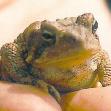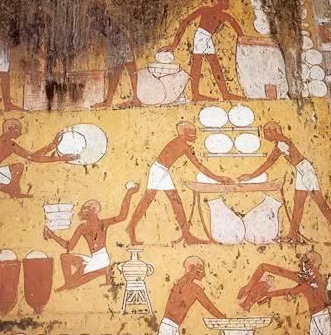
 |

 Men-kheper-re Tut-Moses III basalt Luxor Museum 0250x375.jpg) |
One midsummer morning, Mosh•ëhꞋ mused to A•ha•ronꞋ how the summer was extraordinarily hot and windy. "Any day now," Mosh•ëhꞋ noted, "the Nile is going to show signs of another blood tide.![]() That always sets off a string of fairly predictable mak•ōtꞋ. The Egyptian scientists
That always sets off a string of fairly predictable mak•ōtꞋ. The Egyptian scientists![]() also know about them but they will still serve to muster the am and force Par•ohꞋ's hand to send the am of é‑‑ä forth from Mi•tzᵊraꞋyim.
also know about them but they will still serve to muster the am and force Par•ohꞋ's hand to send the am of é‑‑ä forth from Mi•tzᵊraꞋyim.
Reassuringly, é‑‑ä reminded Mosh•ëhꞋ:
“Like I told you! Par•ohꞋ harbors such arrogant-defiance in his heart that he refuses to send the am forth.
Go
to Par•ohꞋ in the morning when he goes down to bathe in the Nile. Stand on the bank awaiting him to come up out of the river – without his crown, naked, outside of his royal court, just your adoptive step-nephew and you. But you shall take your snake-illusion scepter in your hand and tell him: ‘é‑‑ä ël•oh•imꞋ of the Ha•birꞋu has sent me to you saying, «Send My am forth so that they can serve me ba-Mi•dᵊbarꞋ!» But look, so far you've refused. So é‑‑ä has said, «Hereby you shall know that I am é‑‑ä: Look, I shall strike my scepter on the water of the Nile and they shall change to blood! Fish in the Nile will die and the Nile shall become polluted and Mi•tzᵊraꞋyim shall get grossed-out drinking from the Nile.» ’ ”
Then é‑‑ä said,
“Tell A•ha•ronꞋ, ‘Take your illusion-scepter and stretch
it forth in your hand over the waters of Mi•tzᵊraꞋyim, over their rivers, over their Nile tributaries, over their lakes and pools, that they may become blood
throughout ërꞋëtz Mi•tzᵊraꞋyim; both in wood vessels or stone vessels.’ ”
 |
So, in the morning, Mosh•ëhꞋ and A•ha•ronꞋ did so, as é‑‑ä had commanded. As Par•ohꞋ and his court watched, A•ha•ronꞋ lifted up the scepter and struck the waters of the Nile. As the days passed, the waters of the Nile exploded in a devastating red tide algal bloom. Fish in the Nile died, lining the banks of the Nile with dead fish and red tide, so polluted that the Mi•tzᵊraꞋyim couldn't drink from the Nile. The red tide toxicity and rotting fish bacteria spread throughout the Nile tributaries, irrigation canals and holding ponds throughout ërꞋëtz Mi•tzᵊraꞋyim. People had to dig shallow wells near the banks of the Nile just to get drinking water.
But the Egyptian glyphomancer![]() scientists
scientists![]() performed the same illusion using pyromancy.
performed the same illusion using pyromancy.![]() So this only goaded the arrogant-defiance harbored in Par•ohꞋ's heart and he dismissed their illusions and predictions — as é‑‑ä had said. Then Par•ohꞋ turned his back on them and went back into his palace.
So this only goaded the arrogant-defiance harbored in Par•ohꞋ's heart and he dismissed their illusions and predictions — as é‑‑ä had said. Then Par•ohꞋ turned his back on them and went back into his palace.
So all of Mi•tzᵊraꞋyim had to dig shallow wells near the banks of the Nile because they couldn't drink directly from its waters. This went on for 7 days after é‑‑ä had struck the waters of the Nile.
 |
| Bufo toad |
As Mosh•ëhꞋ and A•ha•ronꞋ mused over the severity of the summer's blood tide, Mosh•ëhꞋ noted that the blood tide always drove huge swarms of TzᵊpharᵊdeiꞋa![]() out of the toxic water onto land. Keeping a watchful eye for the TzᵊpharᵊdeiꞋa
out of the toxic water onto land. Keeping a watchful eye for the TzᵊpharᵊdeiꞋa![]() to begin fleeing the water, Mosh•ëhꞋ soon noticed a few appearing on land. Knowing from experience in previous blood tide years that the swarm was impending to follow, he arranged to see Par•ohꞋ again.
to begin fleeing the water, Mosh•ëhꞋ soon noticed a few appearing on land. Knowing from experience in previous blood tide years that the swarm was impending to follow, he arranged to see Par•ohꞋ again.
Nearing midsummer, é‑‑ä told Mosh•ëhꞋ,
 BAS 350x233.jpg) |
“Come
again in to Par•ohꞋ. This time, tell him, ‘Thus says, é‑‑ä, «Send forth My am so that they may serve Me! And if you refuse to send them, look, I shall strike all of you borders with TzᵊpharᵊdeiꞋa.
The Nile shall swarm with TzᵊpharᵊdeiꞋa,
which shall ascend from the Nile and come into your house, into your bedroom, on your bed, in the house of your workers and on your people; in your earthen ovens
and in your kneading-troughs.
Thus shall TzᵊpharᵊdeiꞋa
come upon you, upon your am and upon all of your workers.» ’ ”
 |
| Ancient Egypt bread-making process (bottom to top) (kneading-trough table center-right) |
So A•ha•ronꞋ stretched-forth![]() his scepter and the TzᵊpharᵊdeiꞋa
his scepter and the TzᵊpharᵊdeiꞋa![]() swarmed throughout Mi•tzᵊraꞋyim.
swarmed throughout Mi•tzᵊraꞋyim.
But the Egyptian glyphomancer![]() scientists
scientists![]() performed the same illusion using pyromancy.
performed the same illusion using pyromancy.![]()
Soon, Mosh•ëhꞋ thought, we can expect a cold snap that will prompt the TzᵊpharᵊdeiꞋa![]() to hibernate. He waited and watched for them to begin hibernating so he could discern when to prod Par•ohꞋ into another meeting to offer relief from them. But, instead, he noticed that the TzᵊpharᵊdeiꞋa
to hibernate. He waited and watched for them to begin hibernating so he could discern when to prod Par•ohꞋ into another meeting to offer relief from them. But, instead, he noticed that the TzᵊpharᵊdeiꞋa![]() quickly began to die from the toxins they had absorbed in the blood tide. Reacting quickly, Mosh•ëhꞋ instigated a meeting with Par•ohꞋ to negotiate sending Israel forth from Egypt in exchange for instant relief from the swarms of TzᵊpharᵊdeiꞋa.
quickly began to die from the toxins they had absorbed in the blood tide. Reacting quickly, Mosh•ëhꞋ instigated a meeting with Par•ohꞋ to negotiate sending Israel forth from Egypt in exchange for instant relief from the swarms of TzᵊpharᵊdeiꞋa.![]()
So Par•ohꞋ summoned Mosh•ëhꞋ and A•ha•ronꞋ, saying, "Intercede with é‑‑ä. Tell him to remove the TzᵊpharᵊdeiꞋa![]() from me and my am and I will send forth the am and they may sacrifice to é‑‑ä.
from me and my am and I will send forth the am and they may sacrifice to é‑‑ä.
But Mosh•ëhꞋ realized that a massive dying-off of the TzᵊpharᵊdeiꞋa![]() had already begun and he had to insist on an immediate deadline.
had already begun and he had to insist on an immediate deadline.
Accordingly, Mosh•ëhꞋ spurred Par•ohꞋ. "So, you need me to intercede for you while you take the credit for sending the am forth? I don't think so! You depend on me interceding in this. You are not in control! Set any deadline for the TzᵊpharᵊdeiꞋa![]() to begin dying-off and I will intercede that deadline on your behalf!"
to begin dying-off and I will intercede that deadline on your behalf!"
"Tomorrow!" Par•ohꞋ snapped furiously.
"As you've said!" barked Mosh•ëhꞋ back at him. "So that you shall know that there is none like é‑‑ä, ël•oh•imꞋ of Bᵊn•eiꞋ-Yi•sᵊrâ•eilꞋ!"
Sure enough, the following day began a massive die-off of the TzᵊpharᵊdeiꞋa![]() in the houses, in the courts and in the fields. The people gathered them into piles and the land stank.
in the houses, in the courts and in the fields. The people gathered them into piles and the land stank.
But when Par•ohꞋ saw that there was relief, this merely goaded the arrogant-defiance harbored in Par•ohꞋ's heart. He reneged on his agreement with Mosh•ëhꞋ and A•ha•ronꞋ — yet again, just like é‑‑ä had predicted.

Optional parental preparation:
Can the child (you?) recite from memory the Mak•ōtꞋ (Hebrew terms) so far? … ,ãÌÈí
Tor•âhꞋ-prohibited supernatural magic aside, there were likely 2 essential factors involved: some temporary coloring powder "sign of things to come" in the scepter, released when the waters were struck, and a year in which the Nile was under greater than usual seasonal (summer) stress (hot & windy), perhaps exacerbated by precursor mini-eruptions or temblors prior to a coming great eruption (c B.C.E. ), raining dust on, or releasing elements from the riverbed into, the Nile, causing reasonably predictable, seasonal (summer) flare-ups of "blood tide" algae.
 |
While freshwater red-tide is usually found in marine waters, freshwater red algal blooms are also documented. "Under certain conditions, algae cells float at the surface of water and form a layer, or “scum.” Scums typically form during still weather after a period of warm and windy conditions. This layer can be pushed to one side by the wind, forming a thick mass of algae (Figure 7). Scums come in a variety of colors – yellow, green, bluish green or even red. Exposure to intense sunlight will kill algae, turning some cells white, so that scums may also develop mottled colors. Red euglenoids are often responsible for red scums on freshwater ponds (Figure 8). Recent research has shown that two Euglena species, Euglena sanguinea and E. granulata, are capable of producing toxins that can kill fish. Apparently, this occurs only rarely. Another type of freshwater red algae (Planktothrix spp.) is known to produce toxins, and it does not form a scum. It is found infrequently at mid-depths in large lakes in early spring. A commonly found genus of freshwater red algae is called “Haematococcus,” and it grows in bird baths (Figure 9)." (Stone, Nathan Extension, Fisheries Specialist, Aquaculture and Fisheries; Daniels, Michael, Professor, Extension Environmental Management Specialist Agriculture. "Algal Blooms, Scums and Mats in Ponds." University of Arkansas. Accessed 2017.05.29.)
Blood tide periodically toxified the Nile — predictably — in summer following a particularly hot and windy period, turning the Nile waters blood-red and causing extensive fish-kills with consequences across the aquatic ecosystem (e.g., an explosion of frogs & toads). When they died, their corpses fed the larvae of swarming insects, etc. Par•ohꞋ and his Egyptian scientists![]() would also have known this.
would also have known this.
This also explains why [1] Egyptian magicians were able to reproduce the illusion and [2] Par•ohꞋ wasn't impressed, and his mind wasn't changed, by these "miracles." ![]()
How would a shallow well near the Nile provide potable (what's potable mean?) water?
What was a scientist in Biblical times?
What does "intercede" mean and what is an "intercessor"?What is the difference between Tor•âhꞋ and the Christian displacement mythology relative to an intercessor?
Questions you might anticipate that your child might raise and be prepared to discuss:
Do you know anyone who is 80? 83?
What is a ruler's cabinet (or court)?
What is a magician's illusion?
What is adopted?
What is a tributary?
What is a irrigation canal?
What is a holding pond?
What does it mean to muse?
What does toxic mean?
What is a deadline?
What does renege mean?
![]()
 |
 |